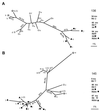Determination of coreceptor usage of human immunodeficiency virus type 1 from patient plasma samples by using a recombinant phenotypic assay
- PMID: 11119595
- PMCID: PMC113919
- DOI: 10.1128/JVI.75.1.251-259.2001
Determination of coreceptor usage of human immunodeficiency virus type 1 from patient plasma samples by using a recombinant phenotypic assay
Abstract
We developed a recombinant virus technique to determine the coreceptor usage of human immunodeficiency virus type 1 (HIV-1) from plasma samples, the source expected to represent the most actively replicating virus population in infected subjects. This method is not subject to selective bias associated with virus isolation in culture, a step required for conventional tropism determination procedures. The addition of a simple subcloning step allowed semiquantitative evaluation of virus populations with a different coreceptor (CCR5 or CXCR4) usage specificity present in each plasma sample. This procedure detected mixtures of CCR5- and CXCR4-exclusive virus populations as well as dualtropic viral variants, in variable proportions. Sequence analysis of dualtropic clones indicated that changes in the V3 loop are necessary for the use of CXCR4 as a coreceptor, but the overall context of the V1-V3 region is important to preserve the capacity to use CCR5. This convenient technique can greatly assist the study of virus evolution and compartmentalization in infected individuals.
Figures



References
-
- Alkhatib G, Combadiere C, Broder C C, Feng Y, Kennedy P E, Murphy P M, Berger E A. CC CKR5: a RANTES, MIP-1alpha, MIP-1beta receptor as a fusion cofactor for macrophage-tropic HIV-1. Science. 1996;272:1955–1998. - PubMed
-
- Berger E A. HIV entry and tropism: the chemokine receptor connection. AIDS. 1997;11:S3–S16. - PubMed
-
- Berger E A, Doms R W, Fenyo E M, Korber B T, Littman D R, Moore J P, Sattentau Q J, Schuitemaker H, Sodroski J, Weiss R A. A new classification for HIV-1. Nature. 1998;391:240. - PubMed
-
- Berger E A, Murphy P M, Farber J M. Chemokine receptors as HIV-1 coreceptors: roles in viral entry, tropism, and disease. Annu Rev Immunol. 1999;17:657–700. - PubMed
Publication types
MeSH terms
Substances
LinkOut - more resources
Full Text Sources
Other Literature Sources
Medical
Molecular Biology Databases

